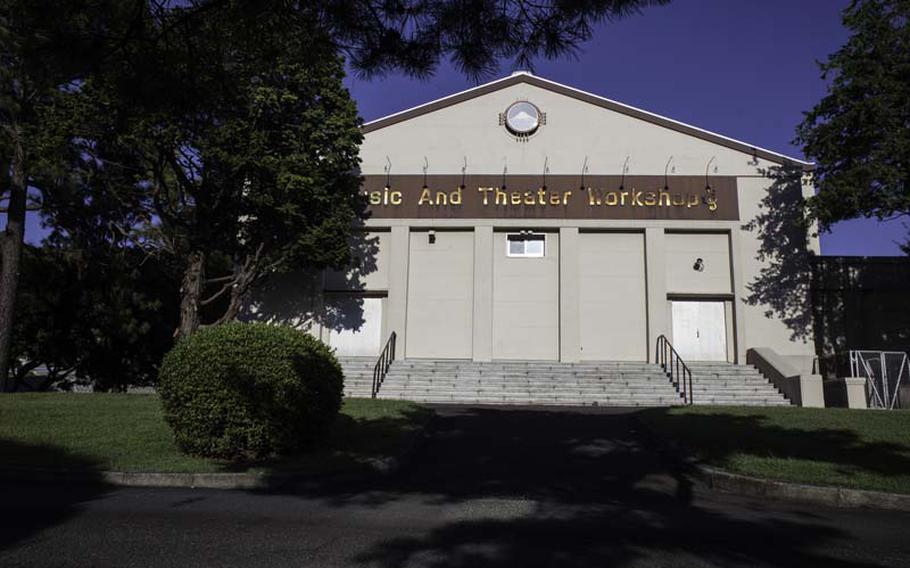
The U.S. military is considering demolishing this WWII-era building on Camp Zama, Japan that once held graduation ceremonies for hundreds of Japanese officer who trained at the Japanese Imperial Military Academy there. The Japanese government is considering preserving the hall. (Nathan A. Bailey/Stars and Stripes)
CAMP ZAMA, Japan — A WWII-era building that once held graduation ceremonies for thousands of Japanese officers sits right in the middle of Camp Zama, where the U.S. Army has announced plans to demolish it — if Japan agrees.
But Tokyo has been slow to make a decision, reflecting the public’s conflicting emotions about its wartime past. While every visit by a top official to a wartime monument is scrutinized and the countries that Japan invaded still demand apologies and even reparations, nationalist sentiment still runs deep, with some rightists insisting the public should find honor in the military’s history.
So, should the building be preserved — at an estimated cost of $1.5 million to bring it up to code? Or should it be razed and become just a historical footnote?
“We’re looking at every possibility,” said R. Slade Walters, spokesman for U.S. Army Garrison Japan. “But we have to be good stewards of historical resources and the taxpayers.”
The building is among dozens of historical landmarks preserved by the U.S. at the base after American forces took control of it in 1945 at the end of the war and renamed it Camp Zama.
In the 67 years since, the U.S. has used the structure for a variety of purposes — including a supply depot, a movie theater and most recently an auditorium — and has significantly altered it over the years.
A 2010 survey of Camp Zama’s historical structures categorized the building as a “property of value that contributes to the cultural heritage of the installation that should be preserved, if practicable.”
Architectural features such as the front colonnade and classical side portico have been removed, and “the building no longer conveys its period of significance and does not retain its historical integrity,” Camp Zama officials wrote in an email to Stars and Stripes.
“Preliminary discussions with [the government of Japan] regarding this issue have been made, but it’s still in coordination,” U.S. Forces Japan told Stars and Stripes in an email.
Japan’s South Kanto Defense Bureau told Stars and Stripes it had received notice from the U.S. military about the possible demolition but had no further comment.
“Imperial Army buildings are very rare, therefore it would be good for [Japan] to preserve it,” said Masashi Nishihara, president of the Research Institute for Peace and Security in Tokyo.
Japan might not want to preserve the building because of lingering perceptions within the Ground Self-Defense Force that the Imperial Army was responsible for Japan’s defeat in WWII, Nishihara said.
The GSDF is in the process of building the headquarters for its Central Readiness Force at Camp Zama, which will bring about 400 Japanese soldiers to the base next year. A small contingent of Japanese GSDF already has been operating at Zama for more than 30 years.
“They may want to have some sort of break with the Imperial Army,” he said.
Conversely, there is an attitude within the Maritime Self-Defense Force that it is a “continuation of the Imperial Navy” and it has preserved many more war-era buildings, said Nishihara, a former president of Japan’s National Defense Academy.
Still, in 1976 the GSDF moved an 8,000-square-foot building once used as quarters for Imperial princes who attended the academy from Camp Zama to Camp Asaka, roughly 30 miles away and headquarters for Japan’s Eastern Army. The U.S. never used that facility after the war in a show of deference to the royals, according to a history of Camp Zama online.
“People may have a negative image of the Imperial Army,” Nishihara said. “But that is our history and I think we should respect it. I hope it can be preserved.”
The base was dubbed Sobudai by Emperor Hirohito at the first commencement held there in December 1937. It was one of two Imperial military academies Japan built outside of Tokyo after the Sino-Japanese war escalated to expand the pipeline of troops who eventually would do battle with U.S. forces after years of fighting in China and elsewhere in Asia.
Hirohito missed only two of the nine ceremonies held at Sobudai — one in 1938 due to illness and the last in 1945 because of the U.S. air raids under way in Tokyo. The emperor’s personal bomb shelter — a dank 300-square-foot chamber encased in reinforced concrete that he never used — still sits behind the graduation hall.
Akira Shiota, 87, a former Army cadet at Sobudai, never got the chance to graduate in “The Great Hall” but was called there with 1,000 other student-soldiers on Aug. 15, 1945, the day Japan surrendered to the U.S.
The commandant of the academy assembled them to relay the message from the emperor that the war was over and that students should not fight back but return to their home towns and “do their best.”
“I remember everyone crying out loud,” Shiota told Stars and Stripes. He had been at the academy less than a year.
Shiota said that he would like the shrine and other memorials from the time of the academy at Camp Zama to be preserved but he understands if the U.S. and Japan cannot preserve the Great Hall.
Stars and Stripes reporter Hana Kusumoto contributed to this report.